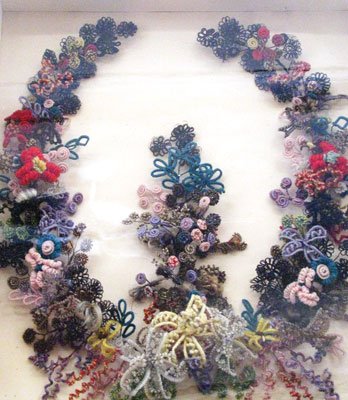At first I could not identify the strange object I found buried
in the bottom of a 45-year-old Schrafft’s Gold Chest chocolate box
from Vermont, part of my mother’s belongings after she died. It
resembled an elaborate wreath of flowers I had seen seen hanging in
a deep shadow box at the Gilroy Museum. At first glance, one would
think it was a made from dried flowers. Upon closer inspection, I
realized that the wreath in the museum was made of human hair.
“Hair is at once the most delicate and lasting of our materials, and survives us, like love. It is so light, so gentle, so escaping from the idea of death, that with a lock of hair belonging to a child or friend, we may almost look up to heaven and compare notes with the angelic nature – may almost say, ‘I have a piece of thee here, not unworthy of thy being now.'” – The Godey’s Lady’s Book of May 1855
At first I could not identify the strange object I found buried in the bottom of a 45-year-old Schrafft’s Gold Chest chocolate box from Vermont, part of my mother’s belongings after she died. It resembled an elaborate wreath of flowers I had seen seen hanging in a deep shadow box at the Gilroy Museum. At first glance, one would think it was a made from dried flowers. Upon closer inspection, I realized that the wreath in the museum was made of human hair.
Now I realized I held a similar wreath in shades of blonde, brunette and every color in between, shaped into intricate flower petals and leaves, all made from my New England ancestors’ hair. Thus began my journey to understand what this mysterious artifact was about.
Imagine a time when there was no photography. Your loved one passed on, and you wanted something to remember him or her by. You might keep a lock of hair. Jewelry containing locks of hair dates back to at least the 1600s, when hair bracelets were given as love tokens by both men and women. During this time, the hair was placed under glass and used as a background for initials or some other personal symbol to the wearer.
“Even today in many baby books, one will see that the mother has saved a lock of her child’s hair,” museum docent Barbara Bottini said.
During the Victorian era, hair art became a craze sweeping across Europe and America. Weaving the hair of living family members into labryrinthine designs using very fine wire, floss and thread became an art form.
Young girls kept scrapbooks of their schoolmates’ hair, usually with a name and verse to go with it identifying whose hair it was. Families kept hair albums the way we have photo albums. Valentines were sent with hair attached. The sentimental sender would glue locks of their hair onto specially made postcards and send it to someone as a keepsake. It was carried in lockets and rings and fashioned into fans, parasol handles, bracelets, earrings and cuff buttons. Napoleon always wore his wife’s hair as a watch chain. When I visited Hawaii, I was fascinated to see an elaborate bracelet on display containing Queen Victoria’s hair, a gift to Queen Emma of Hawaii.
Often hair was tied in separate bunches with wire and twisted, tied and shaped into petals and leaves. Gold, steel or glass beads were used to create the centers of flower designs. Some hair was wound around knitting needles, slipped off and slightly sprung apart to create “wheat,” used to make tendrils and fill the space between blossoms.
When mounting the hair in a wreath-like format to hang on the wall, the two ends of the wreath were always left open at the top, so that a new family member’s hair could be added. The two open ends always pointed heavenward to indicate the loved one’s ultimate journey to the next life.
Until the late 19th century, the techniques for hair work were passed down by word of mouth, making it pretty much a lost art today. However, there are a few rare artists who are endeavoring to unravel the techniques and who continue to design modern versions of these Victorian hair ornaments.
Scientists recently discovered that hair is one of the richest sources of DNA – the shaft seals it inside like a biological protective plastic coating. Rapid advances being made in the study of genetics may enable us to learn even more about our ancestors from the genetic information housed in hair.
The Gilroy Museum, 195 Fifth St., will be hosting a grand anniversary celebration from 10 a.m. to 2 p.m. June 26. In 1910, Gilroy’s beloved Carnegie Library (where the museum is housed) first opened its doors to the community. The Gilroy Museum and the Gilroy Historical Society are honoring this milestone with a big birthday bash.
Please come check out the new exhibits and show your appreciation for the more than 40 volunteers who have kept the museum going. And don’t forget to take a look at that hair art on the south wall.
To see more hair art, visit www.hairwork.com/leila, considered to be the only museum of its kind in the world.
Museum Centennial
What: Celebrate the 1910 opening of the Carnegie Library, the building in which the Gilroy Museum now sits
Where: 195 Fifth St.
When: 10 a.m. to 2 p.m. June 26
Details: 846-0446














